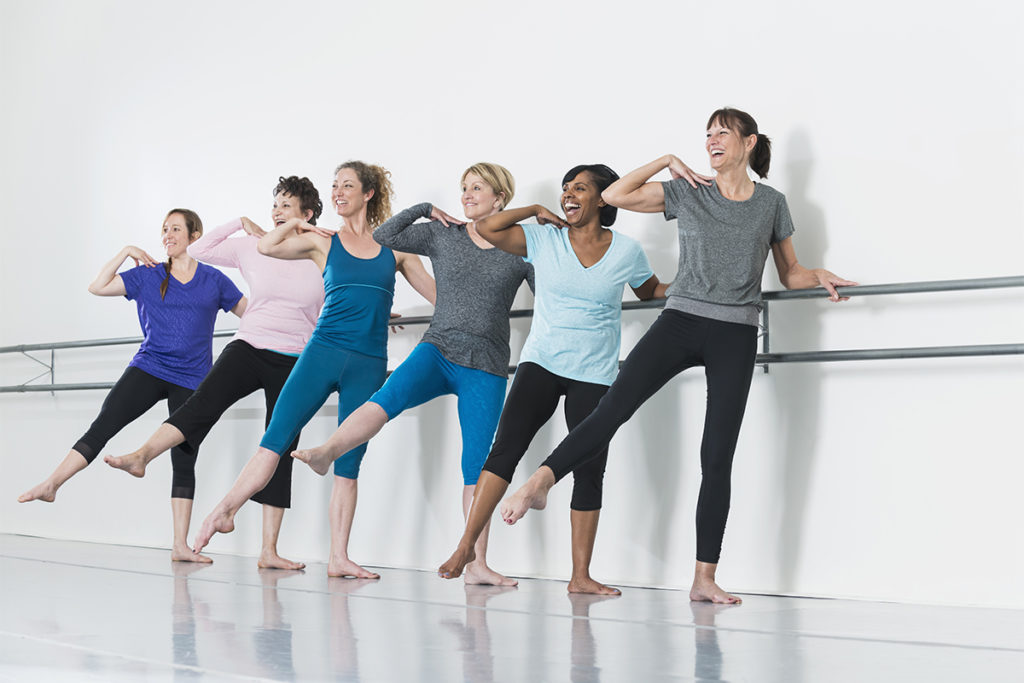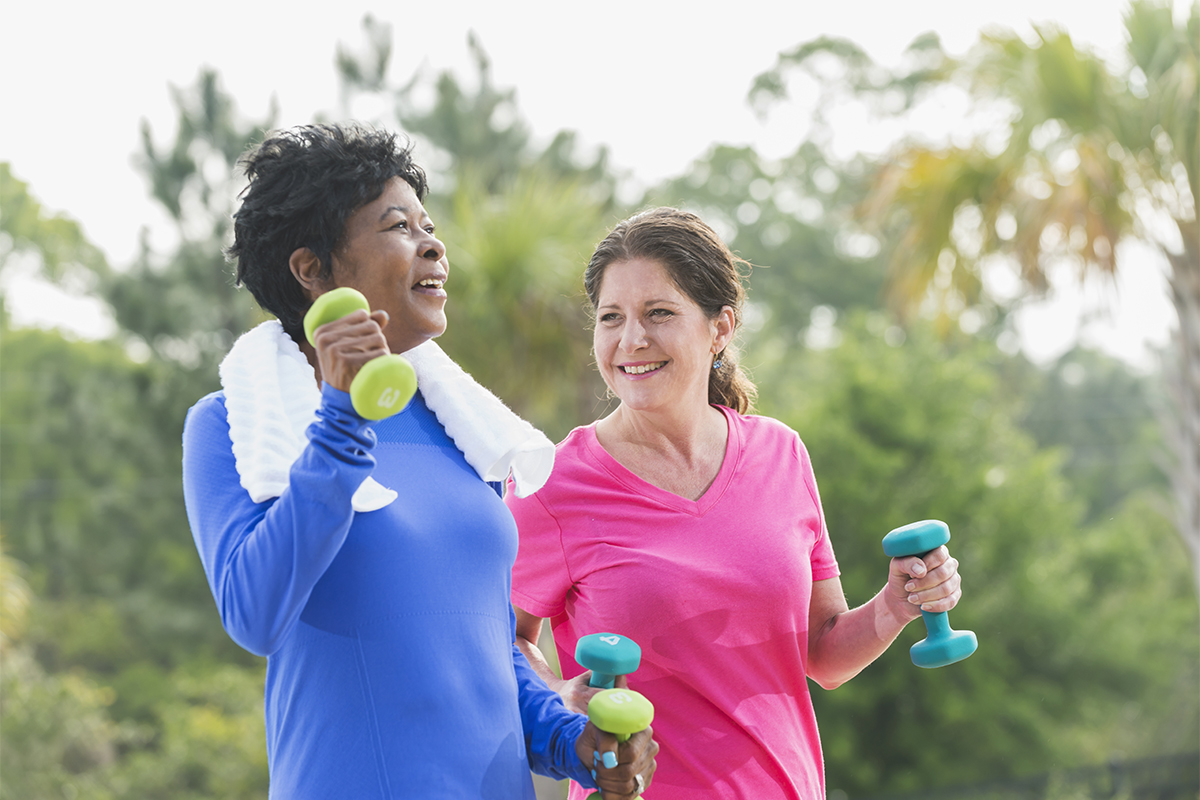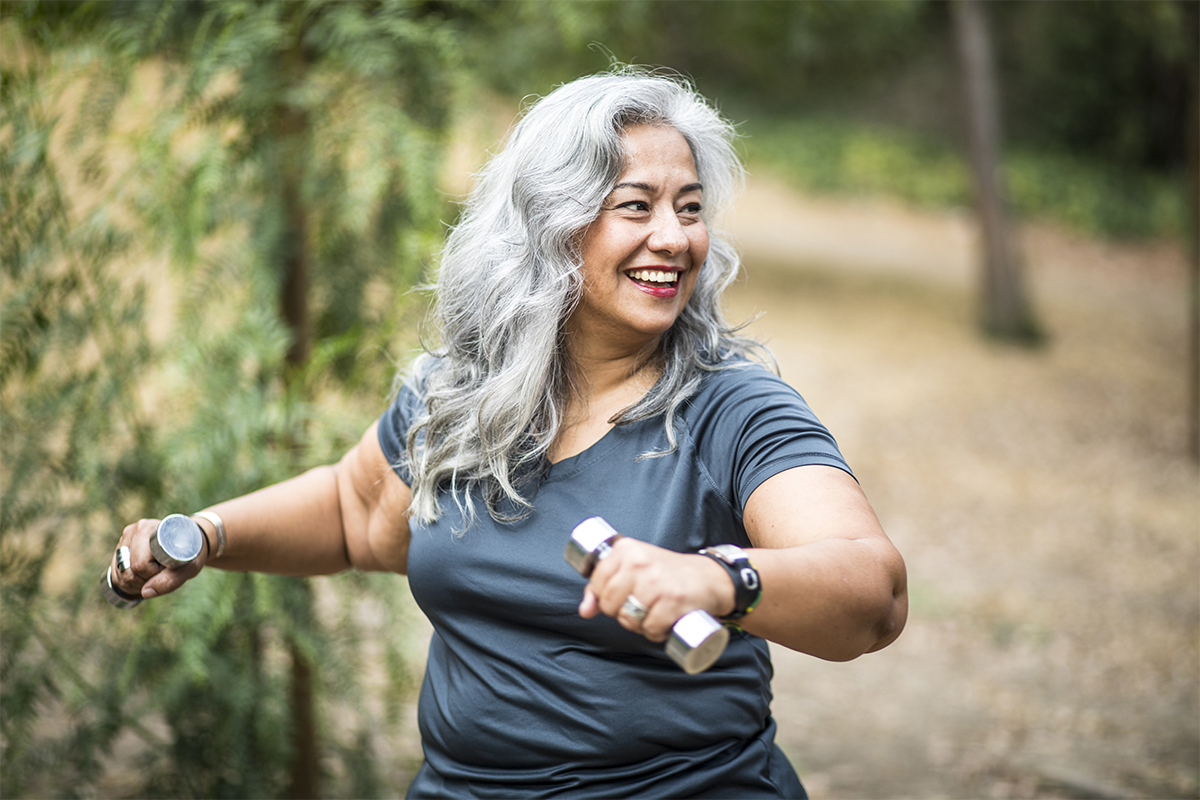Research Update: The Value of Exercise for Women’s Health
Researchers are constantly refreshing our knowledge of the relationship between physical activity and health—the solid base for your program planning.
| Earn 1 CEC - Take Quiz

Fitness pros have a unique opportunity to take a leadership role by guiding their female clients toward a healthier, movement-oriented lifestyle. This women’s health research update discusses contemporary scientific findings you can use to educate your clients and plan up-to-date programs. The five topics, chosen because of the strong influence they have on women’s health, are type 2 diabetes, cardiovascular disease, osteoporosis, anxiety disorders and menopause. Learn about each health condition, associated risk factors and pertinent research developments; then apply the practical training guidelines.
Diabetes and Exercise for Women’s Health
Diabetes is a disease that limits the body’s ability to either produce (type 1) or respond to (type 2) the hormone insulin. This leads to an undesirably altered metabolism of carbohydrates and elevated levels of glucose in the blood. Of the estimated 30.3 million adult cases of diabetes in the United States, 90%–95% are type 2 diabetes (CDC 2017).
Approximately 14.9 million U.S. women aged 18 and older have diabetes. Of that number, 11.7 million have diagnosed diabetes, and the other 3.2 million have undiagnosed diabetes. A woman’s risk of diabetes increases if she smokes, has overweight or obesity, has high blood pressure, is physically inactive, and/or has high cholesterol and high blood sugar (CDC 2017).
An American Diabetes Association (ADA) position stand states that, in people with type 2 diabetes, regular exercise improves blood glucose, helps promote weight loss, reduces cardiovascular risk factors (which are associated with type 2 diabetes) and boosts well-being (Colberg et al. 2016). The position stand further states that since blood glucose management varies with the type of diabetes and the presence of diabetes-related complications, exercise recommendations should be tailored to meet the specific needs of each individual.
See also: How to Motivate Inactive Women to Exercise
Exercise Guidelines
The ADA exercise guidelines for people with diabetes include the following two overarching recommendations (Colberg et al. 2016):
- Exercise every day or at least every 2 days. This recommendation is aimed at increasing insulin sensitivity. One goal is that a person who is insulin-sensitive will require smaller amounts of insulin to lower blood glucose levels.
- Perform both aerobic exercise and resistance training. Women with type 2 diabetes should do both aerobic exercise and resistance training for optimal blood glucose control and health. For clients with type 1 diabetes, the recommendation is to engage in aerobic exercise. Because the effects of resistance training on type 1 diabetes are currently unclear, resistance training for persons with type 1 is encouraged but not specifically recommended.
Training tip: When aerobic and resistance training take place in the same session, the ADA advises doing resistance training first, as this sequencing results in more stable blood glucose control.
Primary Aerobic Exercise Guidelines
Women with diabetes should engage in at least 150 minutes of moderate-to-high volumes of aerobic activity on 3–7 days of the week. This amount is associated with a substantially lower risk of cardiovascular disease and early mortality. In addition, high-intensity interval training has been shown to improve insulin sensitivity and cardiorespiratory fitness in people with diabetes.
Training tip: The ADA suggests progressing clients to vigorous-intensity aerobic exercise as long as there are no complications (Colberg et al. 2016).
Primary Resistance Training Guidelines
ADA recommendations call for a minimum of 2 nonconsecutive days of resistance training each week, eventually progressing to 3 days each week. Exercise programs should include 8–10 exercises to target the major muscle groups of the body. Fitness pros are advised to start clients with single-set training, progressing to 3 sets per exercise. Intensity should begin at a moderate load, 10–15 reps per set, progressing to 8–10 reps per set (heavier load), then 6–8 reps per set (heavier again). All sets are performed to near fatigue.
Balance and Flexibility Exercise Guidelines
The ADA recommends flexibility and balance training on 2–3 days per week. Clients should stretch to the point of mild discomfort and hold the stretch for 10–30 seconds, repeating stretches 2–4 times. Balance training, which can reduce fall risk, may be of any length and should focus primarily on the balance goals and needs of each client (Colberg et al. 2016).
Research Findings on Diabetes and Exercise
In a randomized controlled 16-week study by Alvarez et al. (2016), 23 women with type 2 diabetes who had overweight or obesity (BMI = 30.5 kg/m2, aged 44 ± 1.8) were assigned to a high-intensity interval training group (n = 13) or a control group (n = 10). The HIIT group participated in a running-based program alternating 30-second work intervals at 90%–100% of heart rate reserve (equivalent to an RPE of hard to all-out intensity) with 120-second relief intervals at ≤70% or less HRR (i.e., light intensity). Total exercise time for the HIIT group progressed from 22 to 37 minutes per session over the 16-week study. Results showed significant improvements in both fasting glucose and HbA1c levels from the HIIT training.
Cardiovascular Disease and Exercise for Women’s Health
Cardiovascular disease (CVD), the leading cause of death in women, is a class of diseases that involve the heart and blood vessels. Approximately 1 in every 3 women in the U.S. will die from CVD, which kills one woman every 80 seconds (AHA 2018). Common types of CVD include coronary artery disease, stroke, peripheral artery disease, congestive heart failure, arrhythmias and congenital heart disease.
The underlying mechanisms vary depending on the disease; however, coronary artery disease, stroke and peripheral artery disease involve atherosclerosis, a condition characterized by narrowing and hardening of the arteries due to fatty plaque buildup on the arteries’ inner wall. Over time, arteries can become completely blocked, and two main events may occur: a heart attack or a stroke.
Women can combat CVD by reducing the controllable risk factors shown in the graphic to the right. Additional risk factors are sex-specific (Garcia et al. 2016), including preterm delivery, hypertensive pregnancy disorders, gestational diabetes, some autoimmune diseases, breast cancer treatment and menopausal transition.
Exercise Guidelines
Aerobic Exercise
To improve overall cardiovascular health and function, the American Heart Association (AHA 2017) recommends a minimum of 150 minutes per week of moderate-intensity exercise or 75 minutes per week of vigorous-intensity exercise (or a combination of moderate- and vigorous-intensity exercise).
For people with high blood pressure or high cholesterol, 40 minutes of moderate- to vigorous-intensity aerobic exercise 3–4 times a week is recommended.
Resistance Training
Moderate- to high-intensity muscle-strengthening exercise on at least 2 days per week is recommended for additional benefits to women’s health.
Training tip: A week of exercise could be broken into 2–3 segments of 10–15 minutes each day.
Research Findings on CVD and Exercise
Recent research indicates that efforts to reduce incidence and mortality rates for coronary heart disease in women younger than 55 have plateaued (Garcia et al. 2016). The authors add that women are less likely to receive preventive treatment or guidance, such as lipid-lowering therapy, therapeutic lifestyle changes and aspirin, than are men at similar risk. And when medications are prescribed, the treatment is less likely to be rigorous enough to achieve desired results. Garcia et al. also state that women are 55% less likely than men to participate in cardiac rehabilitation programs, owing to physician referral patterns, program structure or patient preference. However, the findings indicate that higher levels of physical activity are associated with lower rates of chronic diseases, including CVD.
Results of the Cardiovascular Health Study by Soares-Miranda et al. (2015) provide very strong evidence that physical activity, particularly walking, is associated with lower risk of CVD later in life, even in those aged 75 and older. In this study, 4,207 U.S. women and men (aged 73 ± 6 at baseline) were followed for 10 years. Study findings show that walking distance and speed are especially important activity factors, given that walking is the most common type of physical activity as people age. For example, compared with study participants who walked at a speed of 2 miles per hour, those who walked at 3 mph had a 50%, 53% and 50% lower risk of coronary heart disease, stroke and CVD, respectively. And compared with participants who walked 0–5 blocks per week, those who walked 49 or more blocks per week had a 36%, 54% and 47% lower risk of CHD, stroke and CVD, respectively.
A review by Cramer et al. (2014) assessed the positive influences of yoga on risk factors associated with CVD. A total of 44 clinical trials qualified for the review. Results showed that compared with no stimulus, yoga decreased both systolic and diastolic blood pressure, reduced waist circumference, and improved blood lipid levels and measures of insulin sensitivity. All of these positive changes contribute to reductions in CVD risk and improve women’s health. Yoga is practiced by many Americans and recommended by physicians and therapists as a supplement to aerobic and resistance training because of the calming effects yoga can have.
Osteoporosis and Exercise for Women’s Health

Fitness professionals need to tailor exercise to the postmenopausal client’s health and fitness status.
Osteoporosis is an age-related disease associated with the breakdown, thinning and softening of bones. The changes in bone structure reduce bone strength and lead to low bone density, increasing the risk of fracture. According to the U.S. Department of Health and Human Services Office of Women’s Health (HHS-OWH 2017), of the 10 million people in the United States with osteoporosis, 8 million are female. For a look at who is most vulnerable, see the sidebar below “Factors That Increase a Woman’s Risk for Osteoporosis.”
Ultimately, 1 in every 2 Caucasian women in the United States will experience an osteoporosis-related fracture in her lifetime (Xu et al. 2016). It is imperative that fitness pros educate their female clients on proper prevention and care of this disease, which alters lives, reduces women’s health and disables many women every year.
See also: Bone Health: A Primer
Exercise Guidelines
Information from HHS-OWH (2017) states that weight-bearing physical activity is particularly central to building bone and helping to prevent bone loss in women of all ages. From their extensive review, Xu et al. (2016) propose 30–60 minutes of combined-impact loading programs (defined below) on at least 3 days per week. If applicable and tolerable, say Xu et al., this same recommendation can preserve and maintain bone density in postmenopausal women. However, fitness professionals need to tailor exercise to the postmenopausal client’s health and fitness status.
There are four different impact styles to include in exercise programs:
- high-impact loading exercises (e.g., rope jumping, fast running)
- odd-impact loading exercises (e.g., aerobic exercise classes, agility exercises)
- low-impact loading exercises (e.g., slow jogging, brisk walking)
- combined-impact loading exercises (e.g., impact exercises mixed with strength/resistance exercises)
Xu et al. (2016) note that many comprehensive exercise programs for bone health also include balance training to promote muscle function and prevent falls.
Training tip: Start osteoporosis prevention training with teenagers, because girls develop 90% of their bone mass by age 18 (HHS-OWH 2017).
Research Findings on Osteoporosis and Exercise
The LIFTMOR study by Watson et al. (2017) aimed to determine whether high-intensity exercise could safely and effectively increase bone mineral density in postmenopausal women (>58 years) with low bone mass. The modality being investigated was high-intensity resistance and impact training (called HiRIT), which the researchers described as large multijoint compound exercises conducted in weight-bearing positions and involving substantial muscle recruitment; for example, squats and deadlifts.
One hundred and one women were randomly assigned to either an exercise control group (n = 52) or the HiRIT exercise (n = 49) group. Both groups underwent pre- and postintervention testing that measured functional movement using various exercises (timed up-and-go; functional sit-and-reach; 5 times sit-to-stand; back and leg extensor strength; vertical jump) and assessed BMD of the femur head and lumbar spine using DEXA scanning.
The HiRIT exercise group engaged in highly supervised 30-minute exercise sessions scheduled twice weekly for 8 months. During each session, participants performed deadlifts, overhead shoulder presses and squats at 80%–85% of one-repetition maximum for 5 sets of 5 repetitions per exercise. The control group performed unsupervised, low-intensity, home-based exercises consisting of a 10-minute walk to warm up, followed by low-load resistance exercises (first using body weight and working up to 6.6-pound hand weights). Stretching exercises were followed by a 5-minute cooldown period. Sessions were 30 minutes and took place twice weekly for 8 months.
Results from the LIFTMOR study indicate that in properly supervised sessions, HiRIT exercises are safe, beneficial and effective for increasing bone strength and improving functional movement in postmenopausal women with low bone mass. The HiRIT group made superior progress to the control group in every measurement. Also, the level of program compliance was noteworthy. The HiRIT group had an adherence rate of 92% (with a variance of ±11%), indicating a tolerance and enjoyment of the HiRIT exercise format.
Anxiety Disorders and Exercise for Women’s Health

Aerobic exercise and resistance training have favorable influences on anxiety symptoms.
Intermittent worry is a normal part of life for many women. Meeting deadlines at work or school, paying all the bills on time, and making life-changing decisions are events that can add stress and apprehension until the situations are resolved.
In contrast, for a person with an anxiety disorder, the anxiety does not readily go away and may get worse over time. There are several different anxiety disorders: generalized anxiety disorder, social anxiety disorder, panic disorder, obsessive-compulsive disorder and posttraumatic stress disorder. It is estimated that 28.8% of individuals experience an anxiety disorder over their lifetime (Kessler et al. 2005).
Women with a generalized anxiety disorder have excessive worry that may last for months. Symptoms include irritability, muscle tension, difficulty controlling worry, sleep problems and fatigability (HHS 2016a).
A social anxiety disorder is also referred to as a “social phobia.” Women with a social anxiety disorder have a fear of situations where they expect to feel rejected, judged or embarrassed or are fearful of offending others. Symptoms include (1) worrying for days or weeks before an event that other people will be attending; (2) staying away from places where there are other people; (3) having a hard time making friends and keeping friends; and (4) feeling very self-conscious in front of other people (HHS 2016a).
Women with panic disorder have recurring, intermittent panic attacks, which are unforeseen periods of harsh fear that may include accelerated heart rate, heart palpitations, trembling, sweating and shaking (HHS 2016a). Some women may also have sensations of smothering or choking. During a panic attack, the person has feelings of being out of control. Women who experience panic disorders often worry about when the next attack will happen and try to avoid places where a panic attack has previously occurred.
Obsessive-compulsive disorder (OCD) is a persistent disorder in which uncontrollable obsessions (i.e., repeated thoughts, urges or mental images) and compulsions (i.e., repetitive behaviors that a person with OCD feels the urge to do) can interfere with aspects of a woman’s life (HHS 2016b). Common symptoms include aggressive thoughts toward others or oneself; needing things to be in perfect order; fear of germs; and unwanted “forbidden” thoughts involving religion, harm or sex. A woman with OCD may be excessive about cleaning, hand-washing or arranging things in a particular way. Some individuals with OCD also have a tic disorder. This involves repetitive movements, such as blinking, shrugging, grimacing, sniffing, clearing the throat, or jerking the head or shoulders.
Posttraumatic stress disorder (PTSD) is a disorder that some women develop as a result of fear experienced during and after a dangerous or shocking event (HHS 2016c). This fear triggers changes in the body, which reacts with the fight-or-flight response. Women with PTSD may feel stressed or frightened even when they are no longer in danger. It should be noted that any person can get PTSD at any age (HHS 2016c). This includes war veterans but also survivors of physical and sexual assault, abuse, car accidents, disasters, and terror attacks. Symptoms include bad dreams, frightening thoughts and flashbacks—reliving the trauma over and over.
Assessment of any anxiety disorder should start with a visit to a qualified care provider who has experience in helping people with the particular disorder. Anxiety disorders are typically treated with medication, psychotherapy or both.
Exercise Guidelines
Existing research on the effects of exercise for the treatment of anxiety disorders is relatively new and somewhat limited. It’s hoped that more research will eventually lead to guidelines for mode, intensity, duration and frequency.
Research Findings on Anxiety Disorders and Exercise
A study by LeBouthillier & Asmundson (2017) investigated the effectiveness of aerobic and resistance exercise in treating anxiety-related symptoms. In this randomized controlled trial, 48 participants (females and males aged 18–65), all of whom were diagnosed with an anxiety-related disorder, were divided among an aerobic exercise group, a resistance training group and a waitlist group. Participants were initially doing less than 150 minutes of exercise a week, but screening (using the Canadian PAR-Q+) showed that they could safely engage in the study.
Exercise sessions were held 3 times per week for 1 month, supervised by a personal trainer. The aerobic exercise group cycled for 40 minutes at 60%–80% of maximal HRR. The resistance training group performed seven exercises (machine leg press, machine chest press, machine hamstring curl, dumbbell single-arm row, machine shoulder press, machine triceps extension and machine biceps curl), completing 2–3 sets of 10–12 repetitions.
Both aerobic exercise and resistance training were successful in favorably influencing anxiety-related disorder symptoms and related factors.
Menopause and Exercise for Women’s Health

Menopause is an independent risk factor for developing a multitude of chronic diseases, including type 2 diabetes and high cholesterol.
Fitness pros will most likely have a client who is approaching menopause or is well into her postmenopausal stage of life. Women who are entering menopause (i.e., those who are in perimenopause) still have a menstrual cycle, but their estrogen levels are beginning to decline. The average age for a woman to enter perimenopause is mid-40s, but it can occur earlier or later (HHS-OWH 2018).
Natural menopause (not brought on by medical treatment) is officially diagnosed when a woman has not menstruated for 12 months; this typically occurs between the ages of 45–55 but may happen sooner or later. It is a time when the ovaries no longer release eggs and estrogen is no longer produced. Some women experience unnatural menopause due to surgery (i.e., removal of the ovaries) or ovary damage (e.g., from cancer or chemotherapy) (Cleveland Clinic 2017).
When estrogen is no longer produced, a woman’s risk of developing other health-related diseases—such as osteoporosis, heart attack and stroke—increases (HHS-OWH 2018). Other health issues include physical inactivity leading to weight gain and losses in muscular strength and cardiovascular fitness (Shaw et al. 2016). Symptoms that are bothersome and can cause distress in a woman’s life are hot flashes, sleep complications, mood variations, anxiety and depression.
Shaw et al. note that postmenopausal women have a greater prevalence of abdominal obesity, hypertension and elevated fasting glucose concentrations during the 10–14 years after menopause. The researchers suggest that, because of these changes, menopause is an independent risk factor for developing a multitude of chronic diseases, including type 2 diabetes and high cholesterol. (For information on managing weight gain, see the sidebar below “The Truth About Weight Gain With Menopause.”)
See also: Training Loads for Women Over 40
Exercise Guidelines
According to the American College of Obstetricians and Gynecologists (ACOG 2015), regular exercise improves women’s health and slows bone loss.
Cardiovascular exercise. To maintain bone strength, weight-bearing options are encouraged.
Resistance training. Strength training is recommended for muscle strength and bone health.
Balance training is also recommended, as it can help women avoid falls that could lead to broken bones.
Research Findings on Menopause and Exercise
Shaw et al. (2016) sought to determine how resistance training would affect various physiological parameters in 37 postmenopausal women (aged 50–79; body weight = 150 ± 26 pounds; BMI = 25.3 ± 3.5 kg/m2).
For 6 weeks, 19 women completed 40 minutes of RT twice per week. The exercise group performed 3 sets of 10 repetitions (30–90 seconds of rest between sets) at 67%–85% of 1-RM for each of these exercises: dumbbell shoulder press, machine row, machine latissimus dorsi pulldown, machine leg press, barbell squat, machine hip adduction exercise and machine standing calf raise. Participants also did 3 sets of 10 repetitions of dumbbell-loaded pelvic lifts and abdominal curls. The control group (18 women) did not engage in organized exercise but were told to maintain their regular routines.
The resistance group showed significant improvements in upper- and lower-body strength, blood glucose concentrations, systolic and diastolic blood pressure, fat mass, percent body fat, and waist circumference.
Final Thoughts
Use the current research on women’s health and exercise to guide female clients to happier, more physically active lifestyles. You have the power to inspire the women you work with to improve their physical health, which in turn will positively influence their quality of life. The road to optimal health and fitness has no finish line.
A Factors That Increase a Woman’s Risk for Osteoporosis
Postmenopause. A drop in estrogen levels can cause rapid bone loss.
Being Mexican-American, Asian-American or white. Women of these races/ethnicities who are aged 50 or older have a higher risk.
Small body frame. Petite women (under 127 pounds) have a higher risk of developing bone loss.
Family history. A woman has a higher chance of getting osteoporosis if her mother or grandmother had the disease.
Sedentary lifestyle. Physical inactivity does not allow bones to naturally strengthen and grow. Physical activity that includes weight-bearing movements is important for all women, starting in youth and continuing throughout adulthood.
Low calcium and vitamin D intake. Calcium and vitamin D work together to build and maintain strong bones.
Eating disorders. Owing to low body weight, poor nutrition or a restricted diet, eating disorders such as anorexia nervosa and bulimia nervosa can weaken bones.
Amenorrhea. Having no menstrual cycle for 3 months or more suggests women are lacking estrogen, a hormone that helps to maintain bone density.
Smoking. Frequent and large amounts of smoking can diminish bone mass and lead to an increase in bone breaks. Chronic smokers display lower bone density and reach menopause earlier than nonsmokers.
Excessive alcohol consumption. Overconsumption of alcohol has been shown to increase bone mineral loss and exacerbate the risk of falling, leading to bone breaks. Women are advised to have no more than one alcoholic drink per day.
Certain medications. Medicines that are used to treat chronic health problems like arthritis, asthma, lupus and thyroid disease can impair bone health.
Source: Adapted from HHH-OWH 2017.
The Truth About Weight Gain With Menopause
Weight gain in the peri- to post┬¡menopausal stage of a woman’s life is largely due to aging, sedentary behavior, hormonal changes and physical inactivity. All of these factors vary among women.
Results of a 5-year randomized study with more than 500 women (aged 44–50 and perimenopasual at baseline) showed that in healthy women, weight gain and increased waist circumference during peri- to postmenopause can be prevented with long-term lifestyle, dietary and physical activity interventions (Simkin-Silverman et al. 2003). Simkin and colleagues note that to achieve this goal, women need to complete 30–45 minutes of moderate-intensity exercise on most days of the week in addition to following a food consumption plan of 1,300-1,500 kcal per day.
References
ACOG (American College of Obstetricians and Gynecologists). 2015. The menopause years. Accessed Mar. 27, 2018: acog.org/Patients/FAQs/The-Menopause-Years.
AHA (American Heart Association). 2017. American heart association recommendations for physical activity in adults. Accessed Mar. 27, 2018: heart.org/HEARTORG/HealthyLiving/PhysicalActivity/FitnessBasics/American-HeartAssociation-Recommendations-for-Physical-Activity-in-Adults_UCM_307976_Article.jsp#.WrokeYV6Ifo.
AHA. 2018. Heart disease statistics at a glance. Accessed Mar. 27, 2018: goredforwomen.org/about-heart-disease/facts_about_heart_disease_in_women-sub-category/statistics-at-a-glance/.
Alvarez, C., et al. 2016. Low-volume high-intensity interval training as a therapy for type 2 diabetes. International Journal of Sports Medicine, 37, 723-29.
CDC (Centers for Disease Control and Prevention). 2017 National Diabetes Statistics Report, 2017. Atlanta: Centers for Disease Control and Prevention, U.S. Dept. of Health and Human Services.
Cleveland Clinic. 2017. Menopause, perimenopause, and postmenopause. Accessed Mar. 27, 2018: my.clevelandclinic.org/health/diseases/15224-menopause-perimenopause-and-postmenopause.
Colberg, S.R., et al. 2016. Physical activity/exercise and diabetes: A position statement of the American Diabetes Association. Diabetes Care, 39, 2065-79.
Cramer, H., et al. 2014. Effects of yoga on cardiovascular disease risk factors: A systematic review and meta-analysis. International Journal of Cardiology, 173 (2), 170-183.
Garcia, M., et al. 2016. Cardiovascular disease in women: Clinical perspectives. Circulation Research, 118, 1273-93.
HHS (U.S. Department of Health and Human Services). 2016a. National Institutes of Health, National Institute of Mental Health. Anxiety disorders. Accessed Mar. 28, 2018: nimh.nih.gov/health/topics/anxiety-disorders/index.shtml.
HHS. 2016b. National Institutes of Health, National Institute of Mental Health. 2016. Obsessive-compulsive disorder. Accessed Mar. 28, 2018: nimh.nih.gov/health/topics/obsessive-compulsive-disorder-ocd/index.shtml.
HHS. 2016c. National Institutes of Health, National Institute of Mental Health. Post-traumatic stress disorder. Accessed Mar. 28, 2018: nimh.nih.gov/health/publications/post-traumatic-stress-disorder-ptsd/index.shtml.
HHS-OWH (U.S. Department of Health and Human Services, Office of Women’s Health). 2017. Osteoporosis. Accessed Mar. 27, 2018: womenshealth.gov/a-z-topics/osteoporosis.
HHS-OWH. 2018. Menopause basics. Accessed Mar. 27, 2018: womenshealth.gov/menopause/menoause-basics#1.
Kessler, R.C., et al. 2005. Lifetime prevalence and age-of-onset distributions of DSM-IV disorders in the national comorbidity survey replication. Archives of General Psychology, 62, 593-602.
LeBouthillier, D.M., & Asmundson, G.J.G. 2017. The efficacy of aerobic exercise and resistance training as transdiagnostic interventions for anxiety-related disorders and constructs: A randomized controlled trial. Journal of Anxiety Disorders, 52, 43-52.
NHLBI (National Heart, Lung, and Blood Institute). n.d. Heart disease in women. Accessed Mar. 27, 2018: nhlbi.nih.gov/health-topics/heart-disease-women.
Shaw, B.S., et al. 2016. Anthropometric and cardiovascular response to hypertrophic resistance training in postmenopausal women. Menopause, 23 (11), 1176-81.
Simkin-Silverman, L.R., et al. 2003. Lifestyle intervention can prevent weight gain during menopause: Results from a 5-year randomized clinical trial. Annals of Behavioral Medicine, 26 (3), 212-20.
Soares-Miranda L., et al. 2015. Physical activity and risk of coronary heart disease and stroke in older adults: The Cardiovascular Health Study. Circulation, 133 (2), 133-47.
Watson, S.L., et al. 2017. High-intensity resistance and impact training improves bone mineral density and physical function in postmenopausal women with osteopenia and osteoporosis: The LIFTMOR randomized controlled trial. Journal of Bone and Mineral Research, 33 (2), 211-20.
Xu, J., et al. 2016. Effects of exercise on bone status in female subjects, from young girls to postmenopausal women: An overview of systematic reviews and meta-analyses. Sports Medicine, 46, 1165-82.
Len Kravitz, PhD
Len Kravitz, PhD is a professor and program coordinator of exercise science at the University of New Mexico where he recently received the Presidential Award of Distinction and the Outstanding Teacher of the Year award. In addition to being a 2016 inductee into the National Fitness Hall of Fame, Dr. Kravitz was awarded the Fitness Educator of the Year by the American Council on Exercise. Just recently, ACSM honored him with writing the 'Paper of the Year' for the ACSM Health and Fitness Journal.






